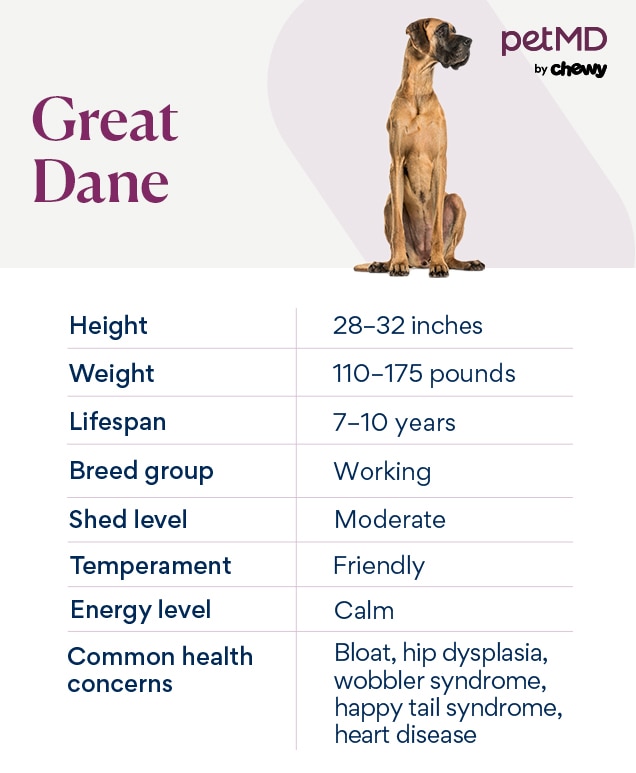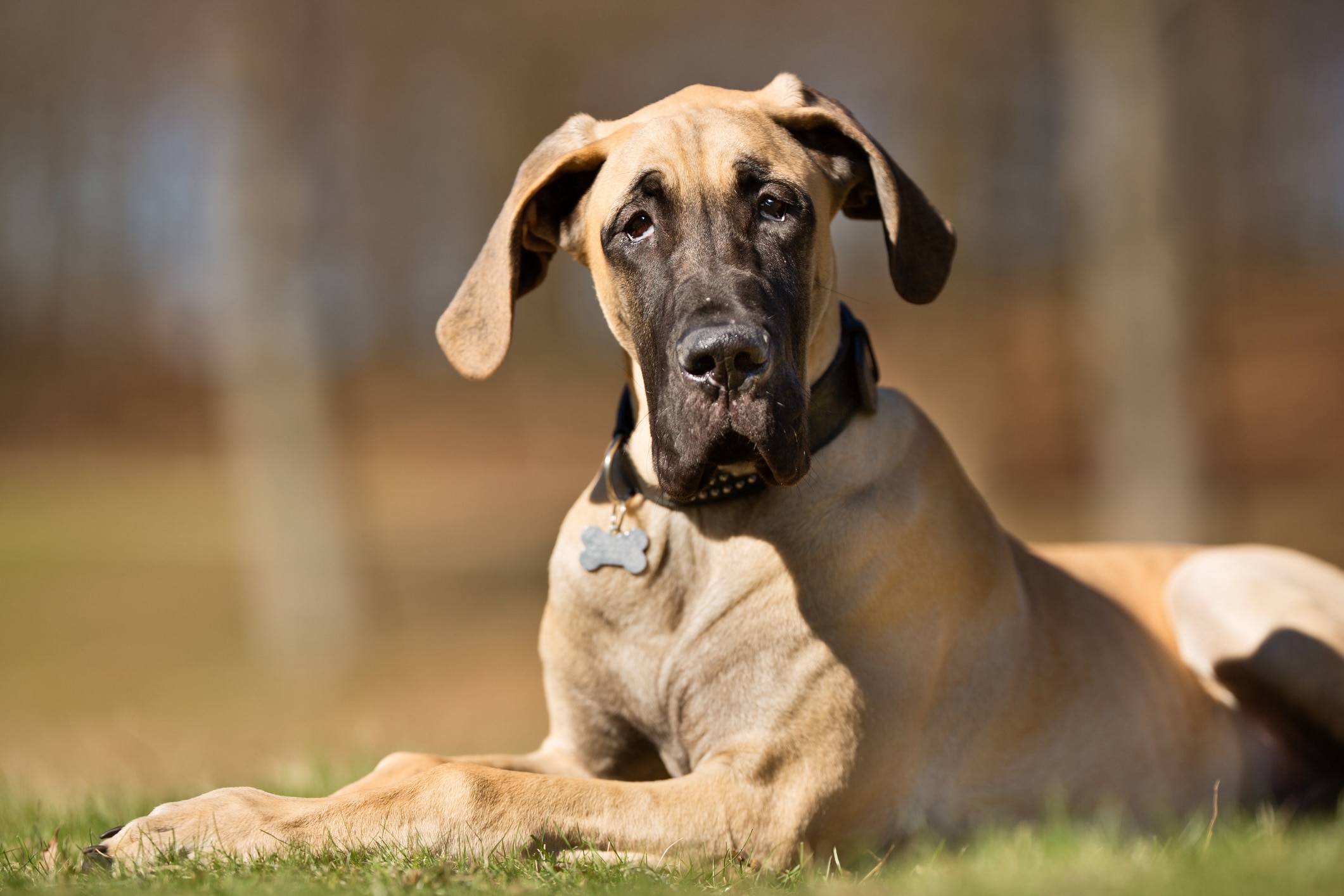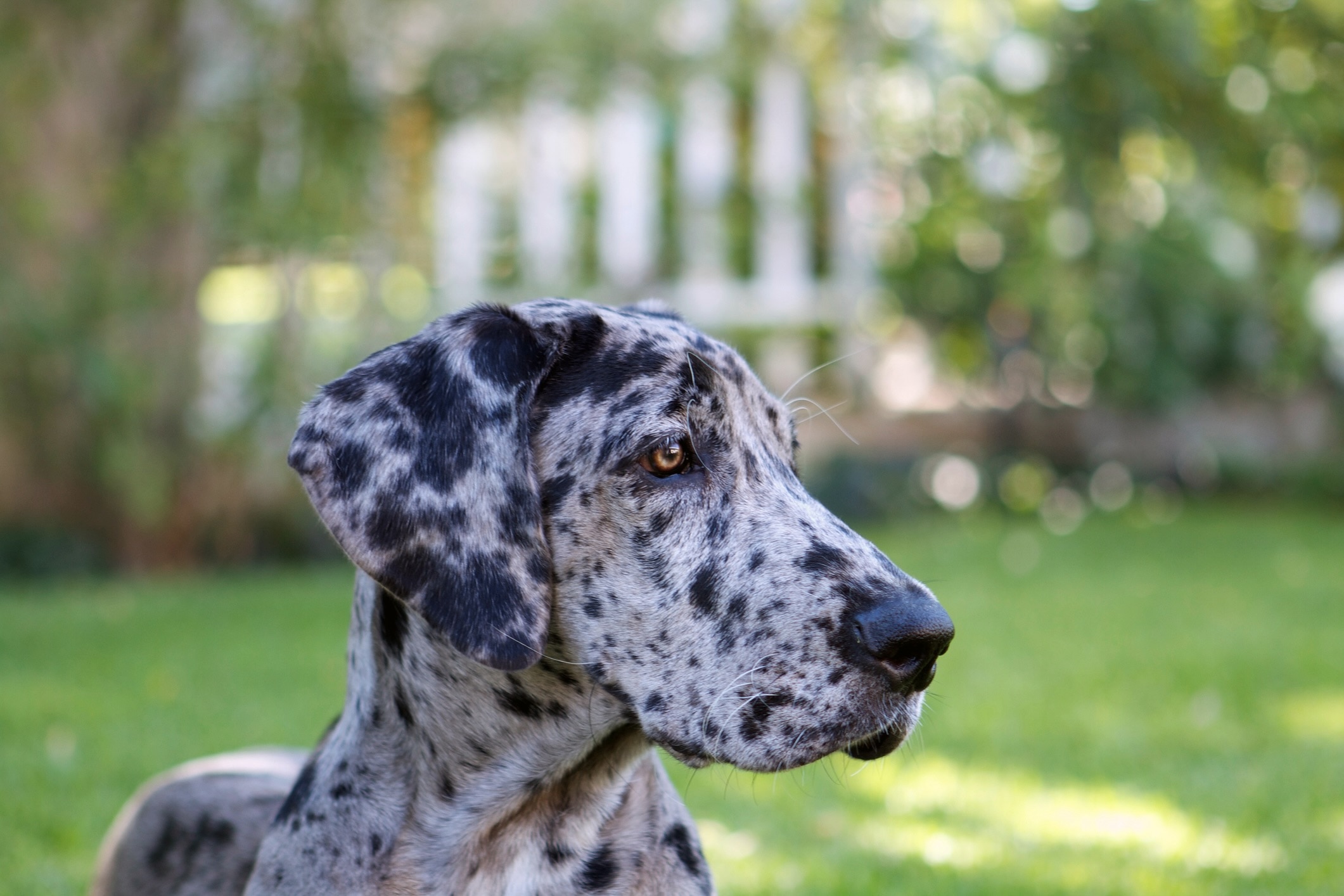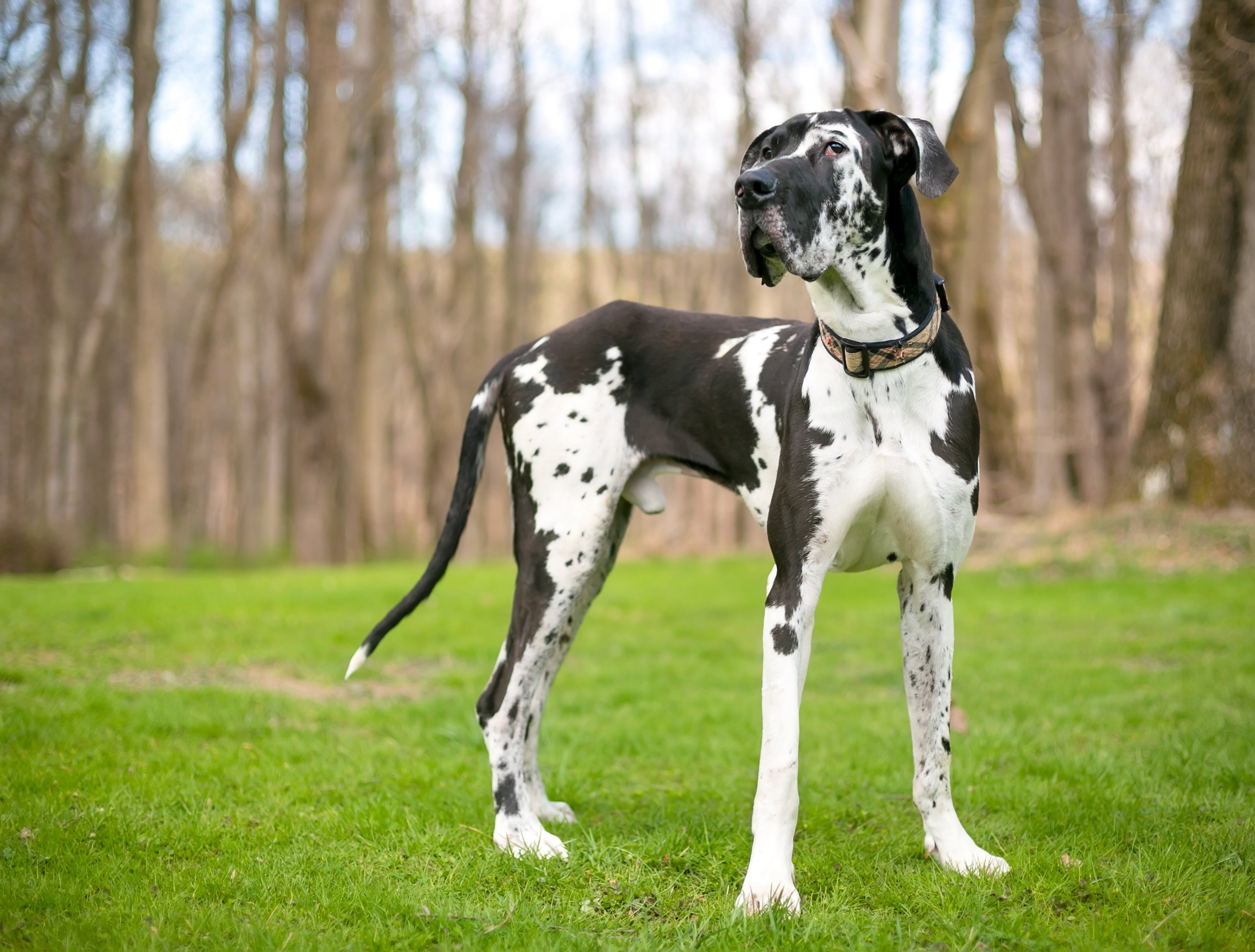Great Dane
dmussman/iStock / Getty Images Plus via Getty Images
The Great Dane is a gentle giant originally bred in the 1800s for hunting wild boar and guarding estates in Germany. It remains a mystery how they came to be named Great Danes, as the breed has no roots in Denmark.
Despite the impressive Great Dane size and guardian history, they are kind and enjoy family life. Nicknamed the “Apollo of dogs,” Great Danes are the tallest in the working class of dog breeds and one of the biggest breeds in existence.
Caring for a Great Dane

Danes are known for their size. A Great Dane’s height falls between 28 and 32 inches tall. The record-holder for the world’s tallest Great Dane, Zeus, stood 41 inches tall (and over 7 feet when standing on his hind legs).
They’re also heavy—the average Great Dane weight is somewhere between 110 and 175 pounds. This growth happens quickly, too, so don’t expect your new Great Dane puppy to stay little for long. According to the Great Dane Club of America, “your puppy will grow as much in his first year as a child grows in fourteen years.”
A Great Dane’s colors include white, black, harlequin, blue, merle, and fawn, among other hues. While colors and patterns vary, all Great Dane dogs have a short coat that, despite not shedding much, needs a weekly brush-through.
Because of their size, the average Great Dane lifespan is shorter than many other dog breeds, at just seven to 10 years. But for pet parents seeking a calm and gentle companion, bringing home a Great Dane puppy can be a great choice—if you’ve got the space for a dog of this size.
Great Dane Health Issues

Along with the shorter life expectancy for Great Danes, the breed is also predisposed to many health issues. Investing in pet insurance may be a good idea if you’re looking to add a Dane to your family.
Bloat and Gastric Dilatation Volvulus (GDV)
One of the most serious medical conditions that more commonly affects Great Danes is gastric dilatation volvulus, or GDV. This is a severe form of bloat in dogs and can be life-threatening in less than 24 hours.
GDV happens when the stomach fills with gas and twists, blocking off the blood supply to the stomach and spleen. This condition can lead to an increasing amount of stress on the heart and can cause dogs to go into shock. A Great Dane is deep-chested, which allows the stomach more room to rotate on its axis.
While it’s not known exactly what causes bloat, it often occurs after a deep-chested dog eats a large meal or drinks a lot of water before exercising. It has also been associated with large breed dogs that eat or drink from elevated food bowl.
Signs of GDV include:
-
Retching or attempts at vomiting with no success
-
Stomach distension and swollen abdomen
-
Restlessness
-
Pacing
-
Panting
If you have a Great Dane and you notice any of these signs, seek emergency veterinary care as soon as possible.
Fortunately, the risk of GDV can be significantly reduced with a preventive surgery called a gastropexy. In this procedure, the veterinarian tacks the stomach to the body wall so it can’t twist in the abdominal cavity. Many pet parents elect to do this procedure while their Great Dane is already under anesthesia for spay or neuter surgery.
Talk to your veterinarian about whether a gastropexy is a good decision for your Great Dane.
Hip Dysplasia
Like many other large breeds, Great Danes can be prone to hip dysplasia, a genetic condition characterized by a hip joint that doesn’t grow properly and becomes loose. Without treatment, arthritis will develop.
Reputable Great Dane breeders should screen their dogs to make sure this genetic condition isn’t passed to puppies. Hip dysplasia can be managed medically, but severe cases my require surgery.
Wobbler Syndrome
Great Danes have a large head and a long neck. Increasing their susceptibility to a neurologic condition called Wobbler syndrome. This disease of the cervical spinal cord causes neck pain and an unsteady, wobbly gait.
This disease is linked to nutrition, so it’s important to feed a growing Great Dane a quality large-breed puppy diet until they are 18 months of age. This diet will help moderate their growth and lessen the risk of both hip dysplasia and Wobbler syndrome.
Degenerative Myelopathy
Additionally, Great Danes and other giant breeds are more likely to have degenerative myelopathy, a spinal condition that causes lower back pain, progressive weakness starting with the hindlegs, and paralysis.
The condition is more common in senior and overweight dogs. The first signs of trouble may include weakness in the back end or hind legs and reluctance to rise after lying down.
Keeping your dog at a healthy weight is one of the best things you can do to reduce their risk of lower back pain. Obesity greatly increases a senior dog’s risk of developing back and joint issues.
Happy Tail Syndrome
In keeping with all other aspects of a Great Dane’s size, the breed’s tail is especially long. This length, combined with their enthusiasm and joy for life, makes Great Danes prone to a condition called happy tail syndrome.
When a Great Dane wags their tail, it may hit objects around it. Happy tail syndrome refers to repeated injuries to the tail tip due to wagging. This repeat trauma results in non-healing wounds on the end of the tail.
Treatment can range from medical management to surgically shortening the tail.
Dilated Cardiomyopathy
Great Danes have a large heart and are prone to a heart disease called dilated cardiomyopathy, or DCM. In this progressive disease, the heart muscle gradually stretches and becomes weak, slowly losing the ability to pump blood efficiently.
While genetics predominantly determine a dog’s risk for developing DCM, nutrition can also play a big role. Symptoms include:
-
Difficulty settling
-
Tiring easily
-
Distended stomach
-
Fainting or collapse
-
Sudden death
If you notice any of these signs in your dog, take them to the vet immediately.
What To Feed a Great Dane

Great Danes need to eat high-quality dog food made for large breeds. Feeding a balanced commercial diet that’s specially formulated for large-breed dogs is the easiest way to ensure that your Great Dane receives optimal nutrition.
Great Dane puppies should eat large-breed puppy food until they are 18 months old. Diets labeled “all life stages” are not appropriate for this size of dog, as Great Danes grow significantly more in height than smaller breeds, and their bones grow for a longer time.
As a large breed, Great Danes may also require more joint support. Many diets are formulated with this in mind and have higher levels of glucosamine and chondroitin than would be necessary for a medium- or small-breed dog.
How To Feed a Great Dane
When feeding a Great Dane, it’s important to reduce their risk of GDV. Here are some ways you can protect your Great Dane during feeding:
-
A slow feeder is recommended to prevent your dog from eating too quickly. These come in many different patterns and colors and act like a maze for your dog’s tongue.
-
Avoid only feeding your dog one meal a day, and instead feed two or more smaller meals.
-
Do not allow your dog to exercise one to two hours after a meal.
-
Avoid using elevated food bowls, which are now thought to increase the occurrence of GDV.
How Much Should You Feed a Great Dane?
Your dog food bag will have the weight of your dog and the amount recommended. This amount changes in growing puppies as they age. Adult Great Danes should be fed two or more meals daily, while Great Dane puppies need three or four small meals every day.
Take care not to overfeed your dog or offer them too many treats. Many degenerative joint diseases have been linked to overfeeding and inappropriate nutrition in growing large-breed dogs. Treats should never be more than 10% of a dog’s daily calorie intake.
Overfeeding and encouraging growth too quickly increases a Great Dane’s risk for hip and elbow dysplasia, osteochondritis, growing pains, and many other orthopedic diseases. Large-breed puppy diets are formulated to minimize this risk by reducing phosphorus, calcium, and vitamin D levels so your puppy grows at an appropriate rate.
If you are unsure that you are feeding your Great Dane an appropriate amount, visit your veterinarian to discuss your dog’s nutritional needs.
Nutritional Tips for Great Danes
Great Danes should receive all necessary nutrients if fed a dog food approved by the Association of American Feed Control Officials (AAFCO). However, joint supplements can be beneficial for this breed.
Many pet parents start their Great Danes on a joint supplement, such as Nutramax® Dasuquin®, to slow degeneration of their hips, knees, and elbows.
Always work with your veterinarian when selecting supplements for your dog. Not all supplements are created equal, and some products have more research and clinical trials to support their efficacy. Your veterinarian is the best person to discuss any supplement additions to your dog’s daily routine.
Behavior and Training Tips for Great Danes
Great Dane Personality and Temperament

All dogs are individuals with their own personality, but Great Danes tend to be very gentle and quiet companions.
Though they won’t have the rambunctious energy of many other breeds, Great Dane dogs can be moderately playful and do require enough space for play and exercise. Expect to take your Great Dane on long walks at least twice a day to provide adequate physical activity.
Great Danes are typically good family dogs and do well with children when trained and socialized from an early age. Interactions between children and all dogs, especially with dogs of a Great Dane’s size, should be supervised.
Great Dane Behavior
While the Great Dane dog breed was originally known as a boar hunter and guardian of estates, the Great Danes of today can be timid and anxious without appropriate socialization.
It’s important to expose your Great Dane puppy to lots of new stimuli, such as other people and pets, within the first four months of life. This will help your dog grow to be confident and fear-free in different situations.
Great Danes that are not well-socialized may suffer from anxiety or be excessively fearful in new situations. These behavior traits can be avoided with early safe exposure to new things and positive experiences.
Great Dane Training
Puppy classes are a wonderful way for your Great Dane to have exposure to new stimuli in a safe and positive environment. Classic obedience courses may also be very enjoyable to Great Danes and their pet parents.
While the breed can be strong-willed during training, they are very intelligent dogs and can learn quickly. Always use positive reinforcement training methods for the best results.
Fun Activities for Great Danes
-
Long walks
-
Going to dog parks
-
Obedience
Great Dane Grooming Guide

Overall, grooming a Great Dane is fairly low-maintenance. But because of their large size, even once-a-week brushing and occasional baths can be a time-consuming endeavor.
Skin Care
Great Danes are not predisposed to any skin conditions, but monitor your dog and contact your vet if you notice any changes. Danes don’t need regular baths unless they are particularly smelly or messy.
Coat Care
While Great Danes don’t shed excessively, because of their size even their moderate shedding level means lots of hair can end up on your floor. Brush your dog at least once a week to reduce the shedding.
Eye Care
Monitor your dog’s eyes for any redness, discharge, cloudiness, or other changes. Contact your vet if you notice anything out of the ordinary.
Ear Care
Great Danes naturally have big, floppy ears. However, it’s common to find Great Danes with cropped ears, which point up.
Ear cropping, or surgically cutting the outer ear to change its shape, is a controversial procedure and many veterinary groups, including the American Veterinary Medical Association and American Animal Hospital Association, oppose the practice. Talk with your veterinarian about whether or not to crop Great Dane ears.
Regardless, it’s important to clean your dog’s ears with a veterinarian-recommended ear cleaner. Without regular cleanings, ear infections can develop.
Considerations for Pet Parents

It is important to note that adding a giant-breed dog to your family can come with some unique challenges.
One major consideration is your budget. Along with the initial cost of buying or adopting a Great Dane, these dogs need more food and larger doses of medications, including monthly flea and tick prevention. This means the essentials are much more costly than they would be for smaller dogs.
Additionally, many Great Danes can weigh as much (or more!) than their pet parents. This makes training socialization especially important, so your dog is well-behaved. Great Danes also need a home with enough space for them to play and stretch out in. While they can live as apartment dogs with a dedicated pet parent, a home with a fenced-in yard is best for this breed.
But for pet parents looking for a giant, gentle dog with a lot of love to give, Great Dane dogs and puppies can be a good fit.
Great Dane FAQs
How long do Great Danes live?
The typical Great Dane life expectancy is seven to 10 years.
Do Great Danes shed?
Yes, Great Danes shed. They don’t shed as profusely as other breeds, but because of their extra-large size, loose fur can still be a problem.
How tall is a Great Dane?
A Great Dane’s height can reach 28–32 inches.
What were Great Danes bred for?
Great Danes were originally bred in Germany to work as guardians and boar hunters.
Is a Great Dane a good family dog?
A Great Dane can be a good family dog. They are typically patient and get along well with children when socialized from an early age.
Are Great Danes smart dogs?
Great Danes are generally intelligent dogs and learn new cues quickly.
How much does a Great Dane cost?
The average Great Dane price can fall between $1,000 and $2,000, depending on several factors. You might also be able to find a dog through Great Dane rescues.
